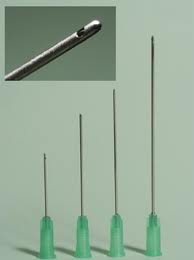The popularity of injectable fillers is undeniable. Adding instant volume to small lips, deepened nasolabial folds or deflated cheeks is truly a marvel of contemporary aesthetic treatments. But besides cost, the number one reason more people don’t take advantage of these facial volumizers is because it hurts to get it done. Like dentistry, the fear of pain keeps many people away from what otherwise may be good for them.
Injectable fillers have been placed since their inception by needle introduction. The needles are quite small but even a 30 gauge in the lips could never be construed by most people as a comfortable experience. There are certainly patients who take it well and view the injections as no big deal. (sort of similar to those few patients like my mother who can have their teeth drilled without ‘novocaine’) But these patients are the exception and most practitioners have some method of reducing the discomfort. My preferred technique is usually regional or local anesthetic blocks but this still requires a needle and some discomfort to do it. It is merely trading off a small discomfort to avoid a bigger and more prolonged one.
Needles are the equivalent of very tiny scalpels with sharp edges. Thus they cut tissues under the skin, sometimes resulting in bruising and more swelling than just from the added volume of the filler. We all have had patients that developed that lip or nasolabial fold bruise, usually at the most undesireable time for them. (before for some important social event)

The one drawback to the use of microcannulas, and it is a small one (no pun intended), is that the microcannula can not pierce the skin. A pilot hole needs to be made with a needle through which the microcannula is then inserted. These small entrance sites can be injected with a drop of local anesthetic if desired which has been my technique to date. The needle used to make the pilot hole needs to be at least one gauge bigger than the microcannula.
For most applications, I prefer the 27 gauge 1 ½” microcannula. It is superb for the lips and the nasolabial folds. Long 30 gauge microcannulas are prone to bending and I see no advantage with their use. Shorter cannula lengths can be used but that then obviates one of the big advantages of its use, being able to treat a whole area through one single entrance site.
Microcannulas are just gaining acceptance in injectable fillers and they are definitely here to stay. They have some real benefits that will improve the patient’s experience and potentially the post-injection period. Their recent existence raises the question that is always asked when a real improvement in technique comes around…what took so long to design something that seems so obvious?
Dr. Barry Eppley
Indianapolis, Indiana


